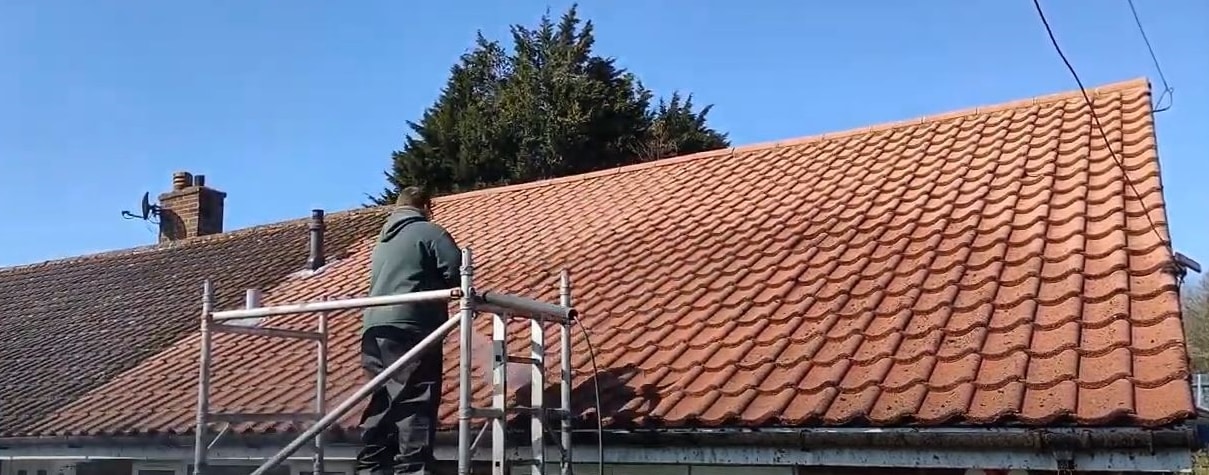How to Get Rid of Black Mold
7 min read
So-known as black mold is a double whammy for property owners. Not only is the toxigenic fungi most likely destructive to your overall health, it’s a absolutely sure indication of a severe dampness difficulty in your dwelling. Luckily, like any mold, it can be eliminated with the suitable mix of materials, know-how and great previous-fashioned elbow grease.
What accurately is “black mold”?
The fact is, there’s no solitary species of black mould out there. Loads of distinctive molds are black in coloration, but you could in no way inform what is what in your house unless you experienced it analyzed by a lab (and it just about under no circumstances would make sense to do that).
When persons chat about “black mould,” they are normally referring to Stachybotrys chartarum, a greenish-black mold that can develop on moist building components, such as drywall and fiberboard, explains Kevin Kennedy, Director of the Environmental Health and fitness System at Children’s Mercy Clinic in Kansas City, MO.
What are the health risks of black mildew?
In a natural way transpiring molds are all all-around us, the two indoors and out. But it’s when mildew lands on a little something soaked, say a damp bathroom wall, and starts to colonize that it gets a challenge. That is when mould spores develop allergens and irritants that can trigger asthma attacks and allergic indicators, such as sneezing, pores and skin rashes and runny noses, in accordance to the U.S. Environmental Defense Agency. In the circumstance of Stachybotrys chartarum, the spores can also make toxic chemical compounds referred to as mycotoxins. But the same is legitimate for lots of molds, given the appropriate ailments. That is why the Middle for Disorder Control and Prevention claims: “It is not necessary to identify what form of mold you could have expanding in your house. All molds need to be treated the identical with regard to likely overall health pitfalls and removing.”
How to get rid of mildew speedy
To start with, you are going to want to identify the dimension of the outbreak. This will tell you if you can thoroughly clean the mildew by yourself, or if it’s arrived at a place wherever you need to convey in the pros. If the outbreak is a lot less than 10 square feet, the EPA claims it is really safe and sound to handle the cleanup you (FEMA sets the restrict at 25 sq. ft, so there is some wiggle place). Specialist mold remediation is highly-priced, costing around $2,000 on common. Which is an additional explanation why it pays to leap on mildew outbreaks ahead of they have a opportunity to unfold.
Assuming the mould cleanup condition is nevertheless Do-it-yourself, start out by accumulating your applications and elements, then adhere to these move-by-stage recommendations for mildew removing.
Applications
- Face mask
- Eye safety
- Rubber gloves
- Vacuum
- Bucket
- Spray bottle
- Sponge
- Scrub brush
- Cloths/rags
Materials
- Dish cleaning soap
- Specialized mildew and mildew cleaner
- Chlorine bleach (if vital)
Instructions
Move 1: Protect by yourself with the right equipment
To stay clear of respiratory in mould spores, have on an N-95 mask. Set on gloves and goggles (without air flow holes) to defend your fingers and eyes from mildew, as perfectly as cleansing brokers.
Move 2: Get rid of any moist merchandise
This is particularly critical following a flood, when issues like furnishings, rugs, bedding and toys may well be soaked. Provided you get to them inside of 48 several hours, there’s a likelihood they can be dried out, cleaned and reused. Check the items for various times, and discard at the 1st signal of mildew.
Step 3: Clean up contaminated surfaces
The mildew-cleansing approach may differ by surface area. Our professionals advise starting off with a light cleaner, and only going onto bleach if the mold persists. Never ever combine bleach with ammonia or other domestic cleaners considering that it will generate a poisonous fuel.
- Partitions and ceilings: If the surface area is really porous, like an acoustic ceiling tile, it is very best to switch it. For easy drywall or plaster, blend a solution of a handful of drops of dish soap, like Dawn Platinum, with a gallon of drinking water. Use the remedy to the mould with a sponge, then rinse with cleanse water. If mildew remains, mix a alternative of ¾ cup of chlorine bleach to a gallon of heat h2o, apply it with a sponge or brush, and rinse.
- Bathroom tile and grout: Tackle compact areas of mold with a specialised cleaner, like Clorox Tilex Mildew and Mildew Remover. Spray the grout, permit the system penetrate, and rinse. If the mildew persists, test a bleach-and-h2o answer an old toothbrush is useful for implementing the answer and scrubbing the grout.
- Shower curtains and liners: If manufactured of plastic, spray moldy areas with a specialised cleaner. Wait for the stains disappear, then rinse with clean up drinking water. You can also wash plastic liners in the washing equipment on the sensitive cycle with heat drinking water, laundry detergent and bleach. If the shower curtain is fabric, wash it on the warmest probable setting, according to the treatment recommendations on the label.
- Wood surfaces: Mildew can increase on wood cabinets, paneling or home furnishings, especially in humid environments. Use a vacuum with a HEPA filter to suck up loose spores with the tender brush attachment. Apply a detergent resolution to the mold with a sponge. Stick to with a fabric dipped in clear h2o, then wipe the area dry. If mold continues to be, move on to the bleach option.
Move 5: Examine back for mold regrowth
However, there’s no crystal clear guideline for how lengthy you need to have to hold out to know if your mold dilemma is fixed. Keep an eye on the space about the next couple times for the return of seen mildew or musty odors.
If you cleaned totally and took treatment of the fundamental moisture challenge (far more on that below), you ought to be in the apparent. If not, it may well be that the mildew is concealed, for example at the rear of wallpaper or on the prime side of ceiling tiles. Industry experts strongly suggest bringing in a qualified remediation service to look into the condition in that case. “In all those exceptional instances where a homeowner’s wellness is significantly impacted by mold, it’s normally for the reason that they commenced ripping open partitions and brought on a large release of spores,” states Kennedy. “It does not come about a ton, but it does occur.”
How to hold mildew from returning
No subject how diligent you are about eradicating noticeable mould, if you really don’t address the underlying concern, it will appear back. “Where there’s mould, there is humidity,” claims Larry Zarker, CEO of the Creating Functionality Institute, which trains and certifies experts who specialize in building wholesome, safe and sound and productive homes. Here are some frequent mildew hangouts in households, together with techniques to eradicate their dampness resource.
- Basements: Make guaranteed gutters are channeling drinking water absent from the house. Plug cracks in basis walls with an epoxy injection system or bring in a pro for the mend. Set up a sump pump to distinct h2o in the celebration of flooding or weighty rain. Place in a dehumidifier to clear away moisture in the air.
- Loos: Maintain the room ventilated by cracking a window, particularly soon after showering. If you have an exhaust fan, operate it even though showering then go away it on for at the very least twenty minutes just after also leave the door ajar. Periodically examine for leaks underneath the sink, as properly as a spongy floor, which could be a indicator of leaky rest room, shower stall or bathtub. Clean up shower grout lines regularly with a specialized grout cleaner designed for the task.
- Ceilings and Partitions: Leaky roofs are the frequent perpetrator right here. Test for lacking shingles or unsuccessful flashing all over openings in the roof, like at a chimney or dormer. Examine siding for cracks or openings, which include where by vents and plumbing strains enter the house.
- Kitchens: Regularly crack a window for ventilation. If you have a assortment hood, run it whilst cooking and then for 20 minutes just after to ventilate steam, alongside with smoke and cooking fumes. Verify beneath the sink for leaks. Examine the seal around your refrigerator if there is sign of mould, air is most likely escaping, so you will require to swap the gasket.
- Windowsills: Seal any cracks about the window where rain is entering with caulk. If condensation is forming on the home windows, and they’re double-pane, you may be ready switch the glass panel to prevent the dampness. But it could possibly be needed to switch the complete unit.
This material is produced and preserved by a third party, and imported onto this web page to support customers offer their electronic mail addresses. You could be able to find much more information about this and comparable content material at piano.io








.jpg)